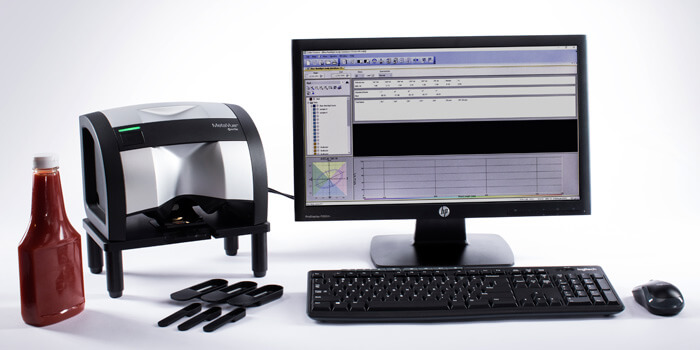There’s been a lot of research around the role color plays in how we expect food to taste. The fact is, we judge flavor by the color of the food or drink, even before the first taste. We expect red foods to taste sweet like strawberries or cherries. White should taste like vanilla, and green is probably limey and tart or minty. Color cues can even determine whether we take that first bite. Most of us won’t even consider trying a food like mashed potatoes or pumpkin pie if it is green.

Considerations for Measuring the Color of Food
Here are the top four things manufacturers should consider when measuring food and how X-Rite solutions can help.
 1. Batch color will vary based on the
ingredients.
1. Batch color will vary based on the
ingredients.
A big challenge in getting food color right is that the color of the ingredients can vary between crops, suppliers, and even seasons. Take tomato sauce for instance. To achieve a uniform color in the final product, each piece must be a shade of red that falls within specific tolerances. Even various types of cocoa used in making chocolate flavors have different shades of brown and red.
Measuring the variation in incoming ingredients can help you quantify color differences and adjust recipes for better color control.
2. Ingredients reflect light differently.
Most manufactured food products contain both solid and liquid ingredients, which reflect light differently. Ice cream, for instance, is made up largely of casein micelles, fat globules, air cells, and ice crystals, all of which reflect light in different intensities depending on the composition of the recipe. Smaller particles and larger volumes of air bubbles will cause the uncolored ice cream to take on a lighter apparent color.
Spectrophotometers like the Ci7800 benchtop are able to measure in both reflectance and transmission modes to accommodate any type of ingredient.
3. The device can’t come in contact with the food.
Not only is this a safety concern, but the differing shapes and texture of food ingredients can make them a challenge to measure. We offer specially designed accessories for many of our instruments to help measure these hard-to-hold samples. "Rigs and Jigs" like the Instrument Stand for the MetaVue VS3200 and the Test Tube Holder for the Ci7600 Orange Juice Grading Solution enable spectros to measure odd shaped, powdered, hard-to-hold, and liquid ingredients.

The Instrument Stand for the MetaVue VS3200 raises the instrument off the table to accommodate various sizes of sample cups and measure samples without contaminating the instrument.
4. It has to happen fast.
Manufacturing plants move fast, and missing a shift in color can have serious financial implications. By measuring the color of samples frequently, quality control personnel can catch and correct small mistakes before they become a big problem. Quality control software like Color iQC can streamline food color measurement and recording in a centralized location for data analysis, reporting, and trend setting.
A Complete Solution to Food Color Measurement
Pairing a non-contact spectrophotometer with quality control software can help you monitor color throughout production and catch errors before they ruin the batch. It can also link production data with shop manufacturing variables, such as ingredients in a particular batch or mixing time, to help you identify and track trends to improve your manufacturing process.
For more information about how manufacturers use X-Rite’s solutions for measuring food, check out our Algida Ice Cream Case Study, Bacardi Mojito Blog, and Measuring Unique Samples Webinar where we demonstrate how to measure mustard. If you need help choosing the best solution for your food measurement needs, get in touch.
